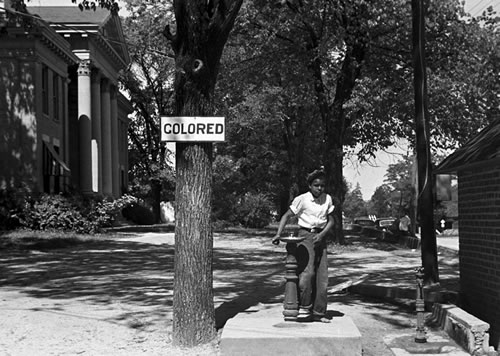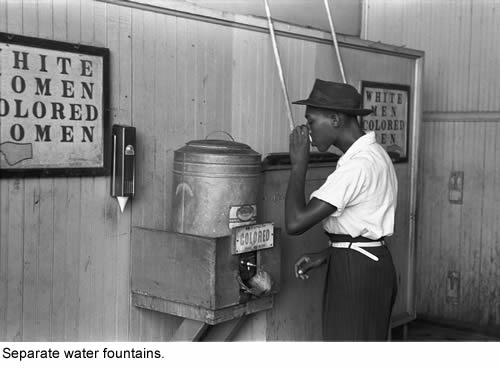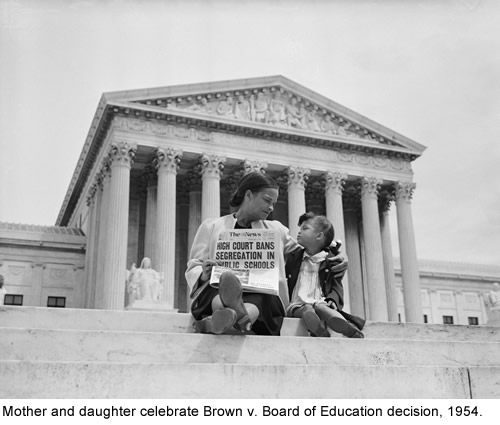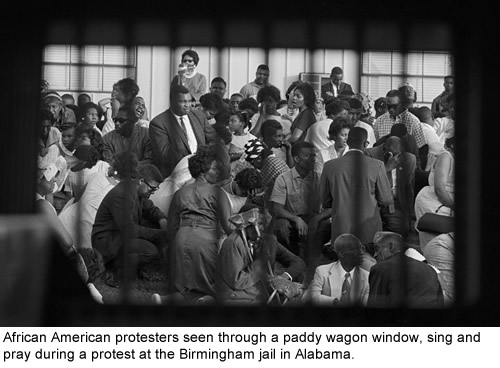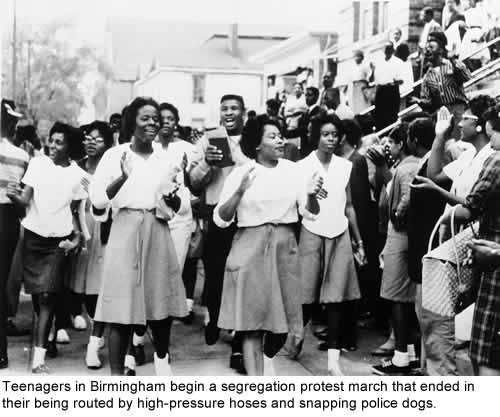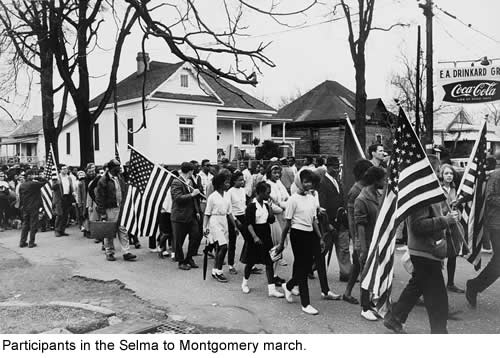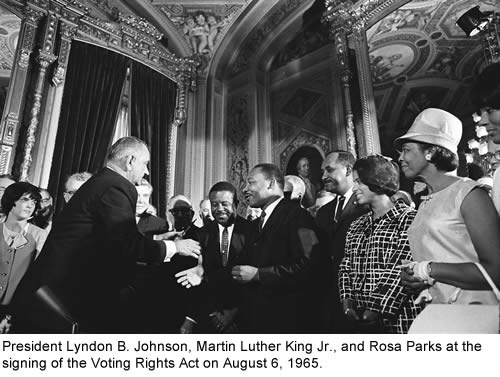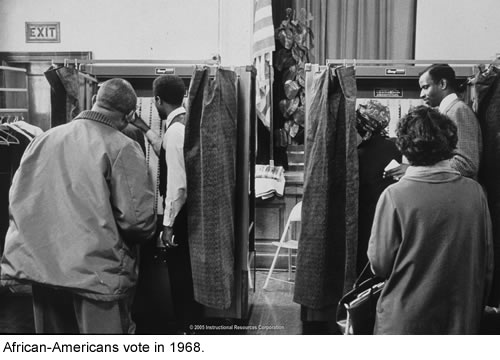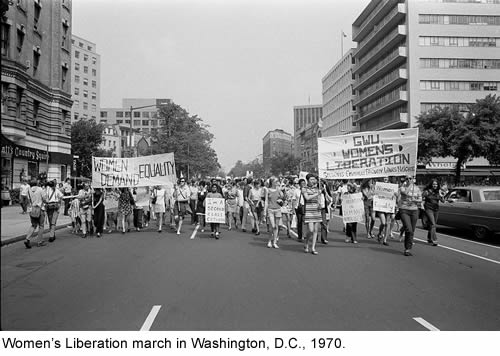Learn
- Inequality
- Jim Crow
- Civil Rights Movement
- 1960s
- Voter Equality
- Selma March
- Free at Last
- Equality for Women
Voters Disenfranchised
Even with the successful passage of the voting amendments, it would be years before women and African-Americans would realize full equality in the workplace, political arena, and elsewhere. African-American voters were often disenfranchised throughout the South. Many were too intimidated by lynching and threats to participate in elections. Requirements such as literacy tests and poll taxes became commonplace.
Americans exercised their freedom of speech and assembly provided by the Constitution to promote legislation during the Civil Rights Movement and Feminist Movement that considerably impacted voting and equality in our nation.
Watch Civil Rights Movement (4:1).
Jim Crow Laws
At the end of reconstruction, Southern States began enacting Jim Crow Laws that segregated African-American citizens and took away their voting rights between 1876 and 1965. Jim Crow operated primarily in the southern states, but did exist in other parts of the nation.
For nearly 100 years after the Civil War, Jim Crow laws created a way of life for African-Americans in which they were treated like second-class citizens with segregated schools, hospitals, and public facilities.
Impact of Jim Crow Laws
Government-sponsored discrimination and racism were the norm and were accepted in much of the United States. African-American civil and political rights were rapidly revoked. The Executive Branch ignored state laws designed to disenfranchise African-Americans, including intimidation and lynching. The Supreme Court upheld Jim Crow laws. African-Americans were denied jobs, housing, and education.
Analyze the photograph. How are the water fountains different? What comes to mind when you see this picture?
Examples of Jim Crow Laws
- In Alabama: It shall be unlawful to conduct a restaurant or other place for the serving of food at which white and colored people are served in the same room.
- In Arizona: The marriage of a person of Caucasian blood with a Negro, Mongolian, Malay, or Hindu shall be null and void.
- In Florida: The schools for white children and the schools for Negro children shall be conducted separately.
- In Georgia: The officer in charge shall not bury or allow to be buried, any colored persons upon ground set apart of used for burial of white persons.
Explore Jim Crow Laws to learn more about these laws and see more examples.
Read Jim Crow Laws.
Brown v. Board of Education
The fight to end the segregation of Jim Crow Laws was the primary focus of the Civil Rights Movement. The 1954 Supreme Court decision in the Brown v. Board of Education case became a major victory in the fight. The Supreme Court ruled that segregation in public schools is unconstitutional, which overturned the "separate but equal" ruling of Plessy v. Ferguson.
Read Brown vs. Board of Education to learn more about the desegregation of schools.
Image credits: Mother and Daughter at U.S. Supreme Court. [Image]. Discovery Education.
The Civil Rights Movement
Although the Civil Rights Movement spread nationwide in the 1960s, the struggle for equality for African-Americans had been going on for decades.
Activists engaged in acts of civil disobedience in the form of non-violent protests including sit-ins, boycotts, and protest marches. Those that dared to cross the color barrier not only risked their livelihood, but also their lives.
Non-violent Protests
The modern-day Civil Rights Movement began with a single act of civil disobedience that would trigger a revolution of change to bring about equality. In December 1955, Rosa Parks refused to give up her seat to a white man on a bus in Montgomery, Alabama. Her actions inspired others to support a mass boycott of the city buses for 381 days known as the Montgomery Bus Boycott. The boycott ignited a movement and promoted its leader, Dr. Martin Luther King, Jr.
Read "Rosa Parks and the Montgomery Bus Boycott" to learn more about the event.
Check out this list of Civil Rights Activists.
Image credits: Segregation Protesters at Jail. [Image]. Discovery Education.; Rosa Parks Riding the Bus, 2006. [Image]. Discovery Education.
The Struggle Continues
The struggles and triumphs of the 1950's segregation battles inspired a generation of young people to become politically and socially active in the 1960s. Some participated in sit-ins at lunch counters to desegregate restaurants that served whites only. Others joined Freedom Rides to test desegregation orders regarding interstate travel. Resistance to these non-violent activities was often strong and sometimes brutal. Protesters endured the threats and violence in an attempt to ensure equality for all. Explore the image below to learn about a sit-in at Woolworth's department store in Jackson, Mississippi on May 28, 1963.
Open Sit-in image in a new tab | Open Sit-in image text version
Note: The presentation may take a moment to load.
Read "The Sit-In Movement" to learn more about the struggles in the 1960s.
Showdown in Birmingham
In the spring of 1963 the nation's attention turned to Birmingham, Alabama, a city Dr. King called, "the most segregated city in American." The protests began nonviolently with marches and sit-ins. When city officials declared the marches violated regulation, the police commissioner, "Bull" Conner, starting using force and arresting protestors, including 900 children from the Children's March.
In the end, it was the horrific televised scenes of children under attack that garnered the much needed attention and support for the Birmingham cause.
The March on Washington
In August 1963, approximately 200,000 white and black supporters converged on the capital to participate in the peaceful and orderly, March on Washington. Many well-known speakers encouraged continued support and non-violent involvement in the movement. The most memorable speech was Dr. King's "I Have a Dream" speech.
The march was organized to focus attention on President Kennedy's Civil Rights Bill. After the death of JFK, President Johnson used his experience to push the Civil Rights Act of 1964 through Congress, which outlawed discrimination based on race and made segregation in public facilities illegal.
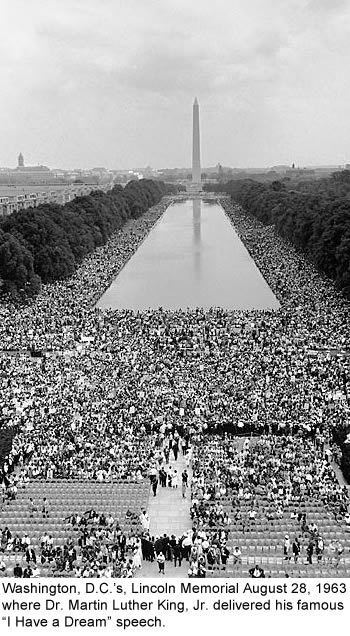
Image credit: Woolworth's sit-in; 28 May 1963 , 1963. [Image]. University of Southern Mississippi Libraries; Segregation Protest March, 2006. [Image]. Discovery Education.
The Fight for Voting Rights
While integration was an important goal of the Civil Rights Movement, ultimately the key to equality would be found in the ability to exercise the right to vote. African-Americans continued to be disenfranchised from voting throughout the south due to discriminatory practices such as literacy tests and poll taxes. President Kennedy pushed Congress to approve the 24th Amendment, which abolished the poll tax.
Read 11 Barriers to Voting to learn more about the obstacles to voting.
Explore "Rise and Fall of Jim Crow" to view a sample literacy test required to register to vote.
Freedom Summer
Change did not come quickly even after the Civil Rights Act. There were many who were angry about the new law, especially in Mississippi where leaders and volunteers of major civil rights groups organized Freedom Summer in 1964 to focus attention on voting rights. Approximately 1,000 volunteers, both African American and white, worked throughout Mississippi to register voters during Freedom Summer.
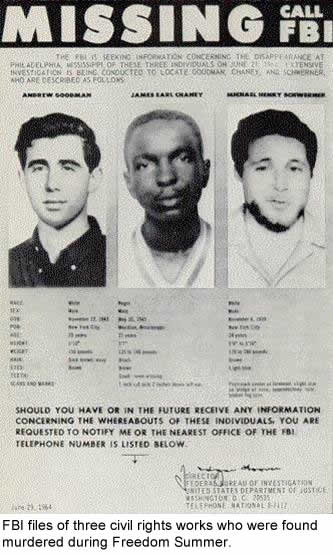
Three young civil rights workers went missing shortly after coming to Mississippi and were later found murdered. As many as 80 mob attacks, 1,000 arrests, and several church burnings took place in Mississippi during Freedom Summer.
Bloody Sunday
The Selma-to-Montgomery March was part of a larger effort to demand voting rights for African-Americans who still had trouble registering to vote due to unfair requirements like literacy tests.
On March 7, 1965, marchers, led by John Lewis, paraded over the Edmund Pettus Bridge in Selma hoping to reach Montgomery, fifty miles away. After crossing the bridge, the marchers encountered violence from the state police who used tear gas and brutalized them with whips and clubs, forcing the marchers into retreat. The images from this event, known as "Bloody Sunday," were televised and horrified viewers across the nation.
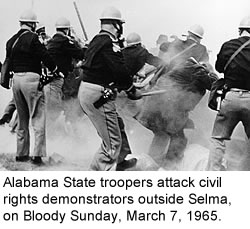
Selma to Montgomery March
The second march, led by Dr. King, turned into a prayer vigil at the site of the bloody attack after a court order prevented the march from taking place.
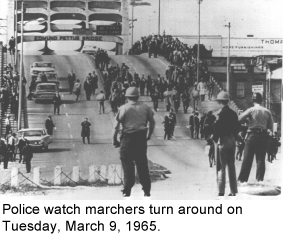
Read "Selma to Montgomery March" to learn more about the march that changed history.
Read How Selma's 'Bloody Sunday' Became a Turning Point in the Civil Rights Movement to learn more about the events in Selma.
Selma to Montgomery March
In the third and final march, President Johnson put the Alabama National Guard under federal control to protect the 25,000 marchers. The third march began on March 21, 1965 and successfully ended in Montgomery five days later.
The events of the three Selma Marches effectively demonstrated the need for voting rights legislation that would force places, such as Alabama, into compliance.
Image credit: Woolworth's sit-in; 28 May 1963 , 1963. [Image]. University of Southern Mississippi Libraries; Segregation Protest March, 2006. [Image]. Discovery Education.
Voting Rights Act of 1965
The marches in Selma helped draw attention to the plight of African-American voters throughout the South. In response, Congress passed the Voting Rights Act of 1965, which removed the final barriers from voting and ensured all American citizens would enjoy the right and privilege of voting.
Federal officials could register voters in places where officials had previoulsy prevented African-Americans from voting. In addition, literacy tests and other barriers were eliminated.
Impact of the Minority Vote
President Johnson signed the Voting Rights Act of 1965, ensuring that all of America's citizens were now able to participate in the "full blessings of American life". As a result of landmark legislation like the Civil Rights Act of 1964, the Voting Rights Act of 1965, and the 24th Amendment, 400,000 African Americans were registered to vote in the South and an entirely new voting population was created in the South.
Read "Gains and Pains" to learn more about the impact of the minority vote.
Political Parties and Minorities
Immediately following the Civil War, African-Americans voted in large numbers in elections and supported the Republican Party, the party that brought an end to slavery.
As Jim Crow laws began to be passed, Southern African-American voters dwindled in numbers; however, they continued to support the Republican Party until the 1930s.
Beginning in the Election of 1932, African-American voters realigned themselves with the Democratic Party and continue to overwhelmingly support Democratic candidates in large numbers today. The African-American vote is today the most solid block of voters in the country.
Image credit: African Americans Voting, 2005 . [Image]. Discovery Education.
Impact of Suffrage for Women
The success of the Civil Rights Movement in the 1960s made it clear to Americans that social protest could actually bring about change. Although women were not a minority and had achieved the right to vote in 1920, they clearly faced inequality in the workforce, education, and politics. Feminist challenged the mainstream stereotypes that limited women to work in the home, raising a family instead of having a career.
The Second Feminist Movement, led by Betty Friedan, inspired the fight for equal treatment that caused female voters to be courted by political parties. Beginning in 1972, the Democratic Party changed its national convention delegate selection process to include more minorities and women among its delegates.
Political Impact
Today both political parties recognize the impact of female voters on national elections and make an effort to actively tailor their party platform to lure those voters and their votes in elections. Increasingly, both democrats and republicans appoint females and minority representatives to prominent political positions recognizing the impact such actions may have on voters.
